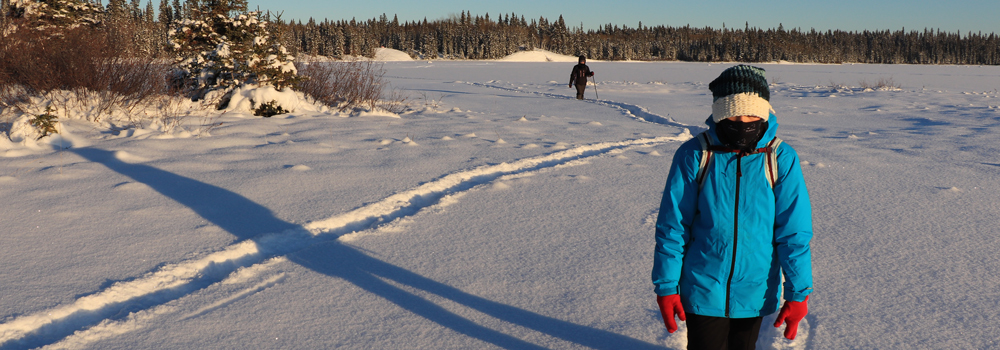
Backcountry Travel
Wood Buffalo National Park
With over 44,000 sq. km of mixed wood boreal forest, fescue meadows, wetlands and lakes for you to discover, Wood Buffalo offers visitors a true wilderness experience. Exploring wild places in the park can be both rewarding and challenging. Make your trip into the backcountry a safe and memorable one. Remember to take the essential items with you, file a trip plan and be familiar with your equipment.
- Hiking
- Paddling
- Backcountry Camping
- Power Boating
- Ski and Snowshoe
Emergencies
In the event of an emergency, you should be prepared for lengthy delays in search and rescue response times due to weather conditions and/or the availability of both aircraft and rescue personnel.
Parks Canada 24 hour emergency dispatch
1-780-852-3100
Cellular telephone coverage is not available or reliable in most areas of the park. Be sure to take a satellite communication device with you into the backcountry.
Hiking and Backpacking
Whether going for an hour or for several days, a hiking or backpacking excursion can be a great way to see new country or revisit favorite areas. While we never plan for things to go wrong, it is important to be prepared for the inconveniences that sometimes arise. Having the essential items in your pack, filing a trip plan, checking current weather forecasts and making sure your gear is in good condition before heading out can keep a minor issue from becoming an emergency. Sometimes things do not go according to plan, so it important to be prepared for any delays or emergencies that may arise.
It is important to be prepared for any emergency or delay that may arise.To learn more about backcountry safety talk to a Parks Canada staff member or visit AdventureSmart.
Backcountry Camping
Backcountry camping is available throughout Wood Buffalo National Park with rustic campsites at Sweetgrass Station and Rainbow Lakes. If hiking Rainbow Lakes, remember that this trail passes through watery and swampy areas of the park, making it a difficult trek. Please inquire with the visitor centre for recent conditions before venturing out. There is no potable water supply located in the backcountry of Wood Buffalo. Be prepared to purify your own water or bring a supply with you. For your safety and the safety of others, keep all fires within the designated fire pits (where available) and check local fire conditions before heading out.
Many of Wood Buffalo’s creeks, marshes and lakes contain higher than usual salt content in the water. Names such as “Salt River”, or “Brine Creek” are testament to this fact! For hundreds of years, Indigenous people and early missionaries harvested and used the salt that was readily available in the area and is unique in the surrounding boreal forest ecosystem. To learn more, drop by the Fort Smith visitor centre or consider joining a summer time hike with a park interpreter.
To stay safe and protect wilderness, travel with two goals in mind: limiting your impact by avoiding encounters and managing your food, food smells and garbage.Following these principles will limit your potential of a negative encounter with bears or other wildlife while backcounry camping. Be sure to:
- Camp in designated areas where provided.
- If random camping, set up cooking, eating, and food storage areas at least 50 metres downwind from your tent. Ensure good visibility so animals cannot approach unseen. Avoid camping, cooking or eating near running water, thick brush, animal trails or berry patches.
- Keep yourself and campsite odour-free. Keep sleeping bags, tents, and sleeping clothes free of food, food odours or beverages.
- Leave smelly cosmetics at home. Store toiletries and personal items with food.
- Store your food, pet food and garbage away from your tent. In random camping areas, hang it between two trees at least 4 metres above the ground and 1.3 metres from top and side supports or use bear resistant canisters instead.
- Wash and store all dishes and food utensils immediately after use. Strain food particles from dishwater and store with garbage. Dump dishwater at least 50 metres from your sleeping area.
- Pack out garbage—do not burn or bury it and do not dispose of it in pit privies.

How to keep a "bare" campsite.
Other ways of ensuring your backcountry safety include, filing a trip plan and bringing all the essential items with you on your trip.For more information on traveling in the back country visit AdventureSmart.
Carrying the essential safety items and filling a trip plan are also steps that you can take to ensure your safety while on the water. To learn more about water safety talk to a Parks Canada Employee or visit AdventureSmart.Backcountry Camping
Skiing and SnowshoeingAll backcountry trails in Wood Buffalo are not regularly maintained during the winter months. Fewer visitors use backcountry trails during the winter months. As a result, backcountry trails may not be clearly visible under the snow and navigation may be required. Exercise caution and watch for icy sections, deep snow and fallen trees.
Plan your routes carefully and file a trip plan before setting out. Plan for the weather and be alert to changes in weather conditions. If needing updated conditions, check in with the Wood Buffalo National Park visitor centre at: 867-872-7960
For tips on preparing for a winter adventure visit AdventureSmart.
- Date modified :